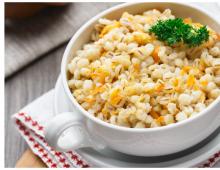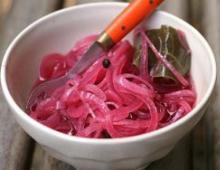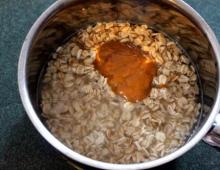Georgian green caviar with eggplant and suluguni cheese. Eggplant caviar for the winter - recipes that will lick your fingers! Eggplant caviar Georgian recipes
Georgian dishes remain a mystery to us today! They have a certain zest that forces our housewives to master the subtleties of Georgian culinary skills. Today we will talk about eggplants and how they are prepared in this wonderful country!
Eggplant caviar is especially popular. In principle, this is not surprising, because mass cultivation of eggplants is widespread there. However, Georgian caviar is completely different from any other eggplant caviar prepared using a different technology!
Georgian eggplant caviar
Take six fresh eggplants, wash them, cut off the stems and skin. The next stage is cutting. Nothing depends on how you chop the vegetables, because it will still be caviar, which means it will be additionally chopped. Therefore, they cut pieces of eggplant at their discretion and, throwing them into a frying pan, fry them. When frying, use any oil, olive, of course, will be best, but to reduce costs, take 12 teaspoons of regular sunflower oil.
In about 15 minutes, the eggplants will reach the desired state, remove, and cool slightly. Once again, pour 8 tablespoons of oil into the frying pan and fry shredded carrots - 2 pieces and a large onion - for about five minutes. Then add 2 tomatoes and 2 sweet peppers. Choose large vegetables, it will taste better. Add 2 pods of hot pepper.
After the tomatoes have been stewed for some time in the total mass, add salt and spices to taste, as well as a chopped bunch of parsley. Lastly, add garlic, use it at your discretion, but no more than 6 large cloves. Using a blender, the eggplant mass is made into one whole and that’s it! Caviar made from eggplants just like in Georgia is ready to serve!
The dish will seem especially tasty if spread on a piece of bread. However, caviar is often served as a salad and eaten literally by the spoonful, appreciating its aroma and pungency of taste!
Such eggplant caviar, or rather the composition of the ingredients, can be changed by adding something new and removing boring tastes, getting a new, no less original dish. If desired, eggplant caviar, prepared in Georgian style, can be transferred to sterilized glass jars, further sterilized, and you will have a wonderful winter preparation!
In general, everything that is prepared using eggplant is incredibly healthy, and you should always have something similar in your home cellar during the winter! This way you can improve your health and just enjoy your favorite treat!
The concept of “Georgian cuisine” was born about 9000 years ago and is a set of dishes and methods of their preparation created by the Georgian people. Although Georgian cuisine is unique in its own way, it has at different times been influenced by Caucasian, Eastern European and Middle Eastern culinary traditions. Each of the regions of Georgia (Abkhazia, Imereti, Guria, Kakheti, Kartli, Adjara, Svaneti, Megrelia and so on) has its own gastronomic features that are different from others. The traditional local menu is famous for its wide variety of meats, but there is also a considerable selection of dishes prepared from products of exclusively plant origin.
The birth of Georgian cuisine was the result of a large-scale mixture of culinary ideas along the entire Great Silk Road, from which traders reached the homeland of the Golden Fleece. The importance of food and drinks for Georgian culture can be clearly seen in the example of such a local gastronomic phenomenon as “supra” - a Georgian feast. During supra, a large number of different dishes are usually put on the table - all kinds of appetizers, meats, vegetables, herbs and sauces. During the supra, a considerable amount of the famous Georgian wine is drunk, and this can last for hours. By the way, the authentic method of producing local wine is one of the oldest in the world. Some varieties of wine in Georgia are aged in giant clay jugs called “qvevri”. Accordingly, such wine is called “kvevris”. The first written mentions of this date back to the eighth century. To conduct the Georgian supra, a “toastmaster” is selected, whose duties include making toasts. The role of the toastmaster in the Georgian feast is important and honorable.
Recipes similar to the popular Georgian eggplant dish “badrijanis hizilala” can be found in many countries of the former USSR, where they are most often called “eggplant caviar”. We have already published several similar recipes earlier on our blog:, , , but as a big and constant fan of this dish, it doesn’t seem to me that there can be too much of it. Therefore, there is nothing unpredictable in the appearance of badrijanis hizilal, another version of eggplant caviar, on our blog.))
How did we get such a strange name attached to this dish, which is widespread in the national cuisines of different nations of the world, where the main ingredient is invariably fried or boiled, and then chopped and mixed with tomatoes, onions, herbs and spices, it is extremely difficult for us to say . In any case, I have not found any clear explanation for this either in the literature or on the Internet. I did not take into account the humorous linguistic connection between eggplant caviar and fish caviar. However, it is possible that once upon a time some unidentified author of this name drew attention to the similarity of small eggplant seeds with fish roe? I can’t say for sure, because all this is just my personal clumsy guesses.
The Georgian version of eggplant caviar, that is, badrijanis hizilala, is somewhat different from all those that we have previously published here. For example, there are no tomatoes in it, but pomegranate juice is added instead. In addition, this dish includes walnuts, widely used in Georgian cuisine.
Ingredients:
- 3 medium-sized eggplants, total weight about 700 grams
- Freshly squeezed juice of one third of a large pomegranate and seeds of one third of the same pomegranate
- 1 small red onion (peeled and finely chopped)
- 2 large cloves garlic (peeled and finely minced)
- One and a half tablespoons of chopped cilantro and dill leaves
- 2 tablespoons pre-roasted, shelled and roughly chopped walnuts
- 40 ml vegetable oil (can be sunflower or olive)
- Black peppercorns (roughly crushed in a mortar)
Preparation:
- In the oven at 220 degrees or on the grill, bake the eggplants until they are soft and their skins are charred. Place the finished eggplants on a cutting board, let cool and peel. Then roughly chop and place in a large bowl.
- Add all the other ingredients here. Salt and pepper. Mix well.
Georgian eggplant caviar is a type of homemade canned preparation that has become a familiar dish for many amateur gardeners. It stores well, complements a dinner or holiday table, and is traditionally consumed as a snack. In order for the vegetable composition to be tasty and nutritious, you need to know how to properly prepare this dish.
Features of preparing eggplant caviar
During preparation for preservation, special attention should be paid to sterilizing containers. The temperature of the water vapor during the procedure should be no lower than 120 degrees. There are various ways to prepare the composition of canned food:
- The standard method is when washed and prepared vegetables are fried until almost done.
- Combined method. The prepared vegetables are lightly fried in a hot frying pan, after which they are chopped.
- No roasting is performed. It is replaced by steam treatment.
Important! When preparing canned food at home, the first method is the most common, since the eggplants are softer.
Product selection rules
To prepare delicious eggplant caviar in Georgian style, you should use only ripe and fresh specimens. In order not to make the wrong choice when purchasing ingredients for canned food in stores and markets, you should consider several useful tips:
- The presence of a stalk. A moderately mature vegetable must contain it. Many unscrupulous sellers know this. In an attempt to hide the truth about the earlier harvest, they get rid of it. You should not thoughtlessly buy eggplants, even if the stalk is present. It should not be wrinkled or have a dark color - this is a sign of overripe vegetables.
- Softness. Try the fruit by touch. It should not be soft and slippery - this fact indicates that it has spent more than one day on the counter. The fresh product is usually quite smooth and light. The skin should be shiny.
- To prepare Georgian eggplant caviar, it is not recommended to use eggplants that are too large. There is a high probability that artificial fertilizers were used to grow the vegetable, which will affect its taste and nutritional qualities and are not beneficial to the body.
Georgian eggplant caviar recipe

To prepare real Georgian eggplant caviar, you will need the following ingredients:
- 4-5 medium-sized eggplants;
- sweet pepper – 1 kg;
- carrots – 700 g;
- onions – 1 kg;
- medium-sized tomatoes – 1.5 kg;
- hot pepper – 2 pods;
- fenugreek, coriander;
- salt, ground pepper;
- vegetable oil.
Important! The amount of the resulting product is relatively small and, as a rule, is quickly consumed fresh. Therefore, for those who want to thoroughly stock up on nutritious preserves for the long winter, you need to multiply the number of ingredients by 2 or 3.
The recipe for making eggplant caviar in Georgian is as follows:
- The first step is to thoroughly wash the fruits and peel them. If this is not done, the caviar will taste bitter. Those who like skinned eggplants can soak them in salt water for 30-40 minutes before cooking to get rid of the unpleasant aftertaste. If you soaked eggplants, squeeze them out a little and let them dry a little. The main thing is not to overdo it.
- Cut into thin strips, add salt to taste. The size of the resulting pieces does not matter, since one of the next steps will be to grind them.
- Finely chop the tomatoes, previously peeled.
- Chop the peeled onion.
- Cut the bell pepper into small cubes, process the hot pepper pods more finely.
- Use a medium grater to process the carrots.
- Rinse the blue pieces with a stream of running water, place them in a cauldron and start frying. Once softened, transfer to a separate pan.
- Add chopped onion to the cauldron and fry until golden brown. Transfer to the pan with the eggplants.
- Place the carrots in the cauldron and fry, then the peppers for 10 minutes, add everything to the pan.
- Simmer the tomato pieces for 10 minutes without adding sunflower oil, and add them to the eggplants.
- Mix the mixture in the pan, add hot pepper, salt and sugar.
- Cook the mixture over low heat for 40 minutes.
- 5 minutes before the end of stewing, pour in vinegar (3 tablespoons) and mix thoroughly.
Georgian eggplant caviar is ready. Each housewife makes her own contribution to the cooking recipe: you can additionally pass all the ingredients through a meat grinder to obtain a homogeneous mass, or act in accordance with the recommendations. Instead of a cauldron, use a large cast iron frying pan. If you do not allow significant deviations from the recipe, the dish will turn out tasty and satisfying. Fresh Georgian eggplant caviar can be served either hot or cold.
Terms and conditions of storage

Place Georgian eggplant caviar to be preserved in sterilized glass jars. Filled containers, closed with sterilized metal lids for preservation, are wrapped for a day. The shelf life of the product when unopened reaches 3 years, while store-bought tins of caviar last a maximum of 2 years.
Storage temperature should be from 0 to 20 degrees. Usually a refrigerator or cellar is used for this purpose. When opened, Georgian eggplant caviar can be stored for no more than 1-2 days.
Conclusion
Georgian eggplant caviar is one of the most delicious vegetable appetizer dishes. It can be used as a side dish or spread on bread, placed on a separate dish or added to the main dish. There are many options. It's always nice to open a jar and enjoy the taste of summer, especially during the winter cold. Homemade preparations prepared according to the Georgian recipe will please all family members. Preparing eggplant caviar in Georgian style does not take much time, and the result is worth the effort.
Georgian eggplant caviar is a very tasty spicy appetizer. Find out the recipes for its preparation now.
Delicious homemade eggplant caviar
Ingredients:
- eggplants – 500 g;
- - 1 PC.;
- fleshy bell pepper – 1 pc.;
- large tomato – 1 pc.;
- spices;
- carrots – 240 g;
- refined vegetable oil – 100 ml;
- parsley – 25 g;
- garlic cloves – 4-5 pcs.;
- salt.
Preparation
We clean the eggplants, chop them into cubes and place them in a frying pan with heated oil. Season with salt and fry for about a quarter of an hour. In another frying pan, saute the chopped onions and carrots for about 5 minutes. Grind the prepared eggplants with sweet peppers and garlic in a meat grinder. Add diced tomatoes, spices and salt to the onions and carrots. Simmer for about a quarter of an hour, and then twist through a meat grinder or grind with a blender. Mix all the ingredients and add chopped parsley. Mix everything well and heat the delicious eggplant caviar for about 4 minutes. And then we let it brew and serve it to the table.
Georgian eggplant caviar for the winter
Ingredients:
- eggplants – 2 kg;
- sweet pepper – 250 g;
- onion – 350 g;
- cilantro, parsley, basil - 50 g each;
- garlic cloves – 10 pcs.;
- – 75 ml.
Preparation
Wash the eggplants well and cut them in half lengthwise. Grease the slices with oil and place on a baking sheet. Bake at 250 degrees for 20 minutes. Then remove the vegetables from the oven, cool and remove the skins. Cut the pulp into small cubes. Chop the onion and pepper into small cubes. We first blanch the tomatoes, and then remove the skin from them and grind them to a puree. Pour oil into a saucepan and heat it, sauté the onion in it, add the pepper and, stirring constantly, cook for about 5 minutes. Then add the tomato and, stirring, simmer over low heat for another 5 minutes. Add eggplant and cook for another 8 minutes. We press the peeled garlic through a press, and finely chop the greens. Place all this in a saucepan, add salt, add a little sugar to taste, if necessary, and cook for about 10 minutes. Place the resulting Georgian eggplant caviar into jars and cover with lids. Place them in a container with water and sterilize them for about a quarter of an hour. After this, immediately seal it, turn it over, wrap it and let it cool. We store the workpiece in the cold.
Homemade eggplant caviar
Ingredients:
- ripe tomatoes – 2.5 kg;
- eggplants – 2.5 kg;
- garlic – 10 cloves;
- onion – 1.4 kg;
- fleshy bell pepper – 1 kg;
- carrots – 900 g;
- salt;
- pepper.
Preparation
We peel all vegetables. Remove the seeds from the pepper. Pour boiling water over the tomatoes and remove the skin. Finely chop the onion and grate the carrots. And we puree the tomatoes. Heat the oil in a saucepan, sauté the onion in it, then add the carrots and cook until soft. Pour it all over with tomato puree. In a preheated oven, bake the peppers and eggplants, and then peel them. We pass the baked vegetables through a meat grinder and then place them in a saucepan. We simmer the caviar for another half hour. Chop the hot pepper very finely and pass the garlic through a press. Place the ingredients in a saucepan, add salt and pepper. We distribute the caviar into jars and immediately close them with sterile lids.




